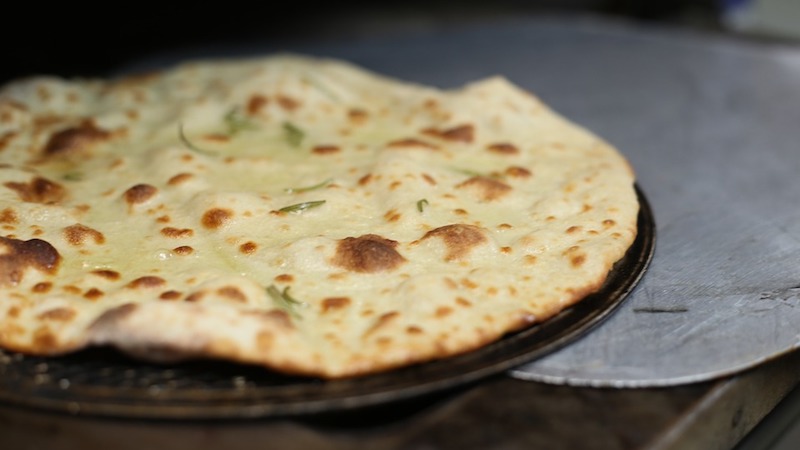Naan
Episode #6 of the course Introduction to bread making by Alice Morgan
Greetings! Yesterday, we learned about French baguettes. Today, we’re off to India for delicious, garlicky, buttery naan.
History
Naan is a form of flatbread common to Southeast and Central Asia and particularly associated with Indian cuisine. The word “naan” originated in Iran, where it was used as a generic term to refer to bread. Breads similar to naan are found in Pakistan, Afghanistan, Iran, Uzbekistan, and the surrounding regions. During the 16th to 19th centuries, naan was popular with the wealthy and royal, who ate the bread with ground mutton or kebabs. It made its appearance in Western writings in a travelogue by William Tooke in 1780 and was served in British Indian restaurants as early as 1926.
Traditionally, naan is made with the use of a tandoor oven. These ovens are capable of temperatures around 900°F (485°C). In fact, the high heat is important because the naan needs to be able to stick to the side of the oven during baking. The dough stretches slightly while baking, giving them their classic tea drop shape. Naan can also be stuffed with a variety of fillings, including mutton or lamb, nuts and raisins, potatoes, or cheese.
Recipe: Garlic Naan (Makes about 8 Loaves)
2 teaspoons (10ml) yeast
2 teaspoons (30ml) honey
3 cups (360g) all-purpose flour
½ teaspoon (2.5g) baking powder
1 teaspoon (5g) of salt
½ cup (125ml) warm milk
1 cup water (250ml) warm water
2½ tablespoons (37ml) olive oil
1 tablespoon (14g) melted butter
3 cloves of minced garlic
Combine milk and water and heat until lukewarm. Add the yeast and sugar to the warm liquid in a large bowl. Let the mixture sit in a warm spot for about ten minutes until the yeast becomes foamy. Add the flour, baking powder, salt, and all 2 ½ tablespoons of olive oil to the liquid. Add as much as an additional ⅓ cup (40g) flour to the dough until it comes together. Turn out and knead the dough on a floured surface until the dough is smooth and just a little bit sticky. If dough feels too wet, add more flour a little bit at time.
Coat the bowl and dough with a little more olive oil (just enough to create a thin layer on the bowl and bread), cover, and allow it to rise in a warm place for one to two hours or until doubled in size. Punch down the risen dough, transfer to a floured surface, and divide the dough into eight round balls. Roll the balls out flat until they are roughly oval shaped, about 6 inches (15cm) wide and 10 inches (30cm) long.
Pre-heat a thick-bottomed pan on high heat. While the pan preheats, melt the butter and press the minced garlic into the top of the naan loaves. Once the the pan is ready, add a little oil and the first naan. Cook for one to two minutes, until the bread starts to look bubbly. Brush the uncooked side with butter, flip the naan, and repeat the process until browned. Brush a little more butter on top of the naan, and serve warm.
Cooking tips:
• To speed the cooking process up, you can also bake the naan. Set your oven to 500°F (260°C), preheat your baking tray, and do the same as if you were cooking them in a pan.
• If you have a gas flame oven, you can get a more authentic naan by using tongs to place it directly on the flame for a few seconds until the loaf is slightly charred.
That’s all for today. I hope you enjoy your fresh, garlicky naan with some tikka masala or curry. Tomorrow, we’ll cover bagels. See you then!
Recommended reading
Recommended book
Made in India: Recipes from an Indian Family Kitchen by Meera Sodha
Share with friends

